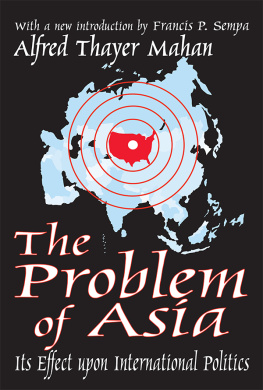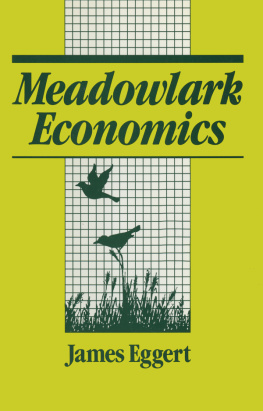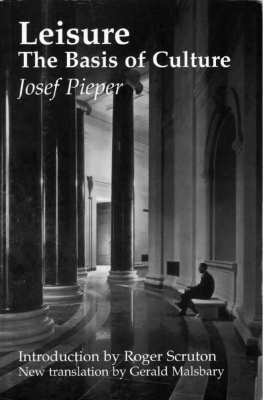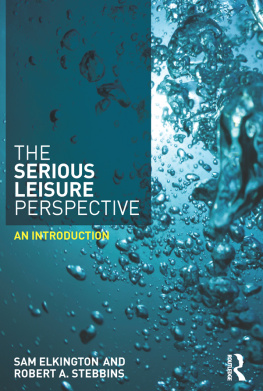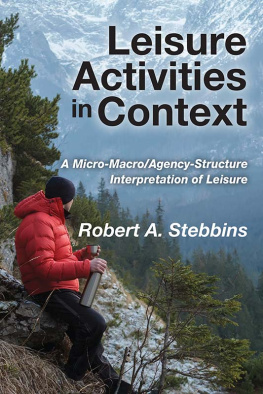Serious Leisure
A Perspective for Our Time
Serious Leisure
Robert A. Stebbins
First published 2007 by Transaction Publishers
Published 2017 by Routledge
2 Park Square, Milton Park, Abingdon, Oxon OX14 4RN
711 Third Avenue, New York, NY 10017, USA
Routledge is an imprint of the Taylor & Francis Group, an informa business
Copyright 2007 by Taylor & Francis
New material this edition copyright 2015 by Taylor & Francis.
All rights reserved. No part of this book may be reprinted or reproduced or utilised in any form or by any electronic, mechanical, or other means, now known or hereafter invented, including photocopying and recording, or in any information storage or retrieval system, without permission in writing from the publishers.
Notice:
Product or corporate names may be trademarks or registered trademarks, and are used only for identification and explanation without intent to infringe.
Library of Congress Catalog Number: 2006050176
Library of Congress Cataloging-in-Publication Data
Stebbins, Robert A., 1938
Serious leisure: a perspective for our time / Robert A. Stebbins.
p. cm.
Includes bibliographical references and index.
ISBN 0-7658-0363-1 (alk. paper)
1. LeisureSociological aspects. I. Title.
GV14.45.S843 2006
306.4'dc22
20006050176
ISBN 13: 978-1-4128-5594-5 (pbk)
ISBN 13: 978-0-7658-0363-4 (hbk)
To Abran, Amlie, Braeden, and Landon
BLEST, who can unconcernedly find hours, days and years, slide soft away, in health of body, peace of mind, quiet of day, should sleep by night, study and ease, together mixedsweet recreation.
Ode on Solitude by Alexander Pope (1717)
Contents
List of Tables and Figures
The SLP as a Formal Grounded Theory
I made the claim early in this book (p. 3) that the serious leisure perspective (SLP) had reached the point where it can be identified as a formal grounded theory. That claim has since been validated over and over by a burgeoning theoretical and empirical literature centered either wholly or substantially on the Perspective or one or two of its three forms (serious, casual, project-based leisure). This includes ethnographic research on particular heretofore unexamined serious leisure activities. There are now over 1,100 references of this nature in the Bibliography found on the SLP website. As an update of , a chronicle of the journey from substantive to formal grounded theoretic status is available in Stebbins (2013) and, in somewhat greater detail, on the site itself (click on History).
The SLP Website
I mention this site on page xv, noting its origin in an adventitious initial encounter with Jenna Hartel. She was at that time a doctoral student in library and information science (LIS) at UCLA. She is now an associate professor in the Faculty of Information, University of Toronto and, as the sites webmaster from the beginning, has been a main player in its growth as well as in the extension of the SLP into LIS. She proposed that the site contain a digital library, which today, houses several digitized, open-source books, theses, articles, and the entire Leisure Reflections series. She also designed the SLP typological diagram and the SLP Involvement Scale, both found on that site. Also available there is an extensive history of the Perspective (it dates to 1973), a summary of its central concepts and propositions, and a page containing our curricula vitae.
In short, this Internet domain has become a vital center for collecting and disseminating scientific information and its application (click on More and then on News) related to the SLP. Being without an organizational base this website is the Perspectives only hub. Dr. Hartel has designed and maintained it, always with this crucial function in mind.
Some important things have happened to the serious leisure perspective (SLP), after being introduced in this book in 2007. One, the SLP has continued to expand as a formal grounded theory. Two, the website that saw the light of day in 2006 has now, under the new URL of www. seriousleisure.net, developed considerably. Three, the basic definition of leisurethe foundational concept of the SLPhas been reformulated. Four, I have proposed a positive sociology based on the SLP, even though sociology as a discipline continues (especially in North America) to keep its distance from the study of leisure. Five, the set of extensions discussed in has grown since 2007.
The Definition of Leisure
Among the general theories commonly discussed in leisure studies, the SLP is the only one whose origins lie directly and substantially in research on free-time activity. That is, the SLP emerged inductively from a foundational set of exploratory studies that were focused first and foremost on various leisure activities (summarized in ). For this reason the Perspective can be qualified as an internal theory, and contrasted with the various external theories that have also been used to explain this sphere of life. Theories like functionalism, symbolic interactionism, critical analysis, and postmodernism contain some ideas on leisure, but they emerged in answer to intellectual questions quite distant from that subject.
It follows that, when developing internal theory, it is vital that its central concepts be defined with as much precision as the scientific knowledge underpinning them (as opposed to commonsense) will allow. My attempts over the years to define the central concept of leisure and its place in the SLP reflect my continual grappling with such knowledge as I have striven to find its essence, its unique features.
In Stebbins (2012) I took the definitional bull by the horns, devoting a small book to the matter wherein I presented, first, a condensed, dictionary-style definition of leisure and, then, a book-length elaboration of it. Serious Leisure offers a condensed definition on pages 4 and 5. The condensed definition of leisure presented in Stebbins (2012, pp. 4-6) differs according to the following italicized passages: un-coerced, contextually framed activity engaged in during free time, which people want to do and, using their abilities and resources, actually do in either a satisfying or a fulfilling way (or both). In other words, any definition of leisure should recognize that it takes place in and is therefore influenced by its historical, cultural, and structural contexts. Moreover, wanting to pursue a serious leisure/devotee work activity can only continue if the participant has the necessary ability and resources, including money, opportunity, personal agency, and possibly, social support.
Apropos definitions, I have also given since 2007 considerable attention to the pivotal idea of activity (Stebbins, 2009a, pp. 4-7). The leisure activities that people engage in and their experiences while doing so constitute an important part of the motivational foundation of the SLP. The condensed definition refers to un-coerced activity. An activity is a type of pursuit, wherein participants in it mentally or physically (often both) think or do something, motivated by the hope of achieving a desired end. Life is filled with activities, both pleasant and unpleasant: sleeping, mowing the lawn, taking the train to work, having a tooth filled, eating lunch, playing tennis matches, running a meeting, and on and on. Activities, as this list illustrates, may be categorized as work, leisure, or non-work obligation.





